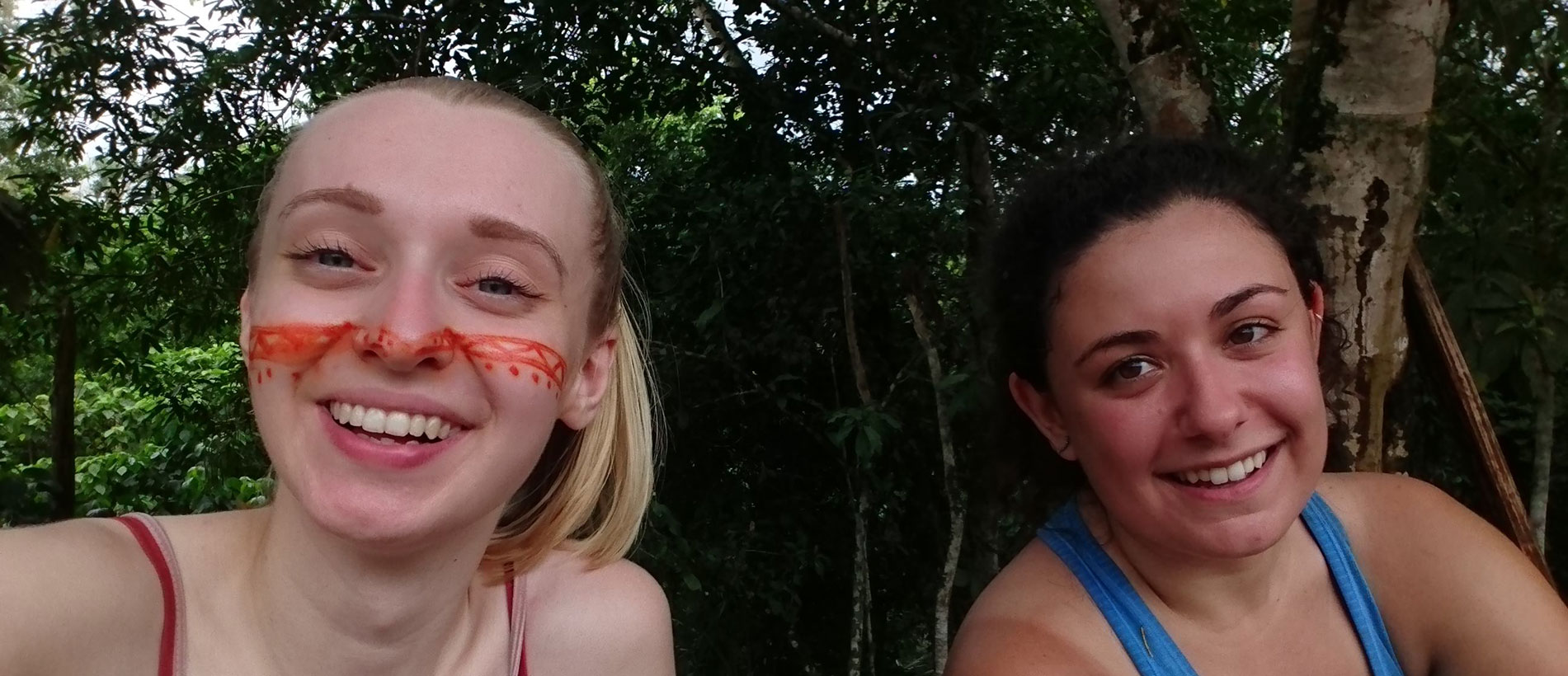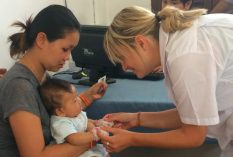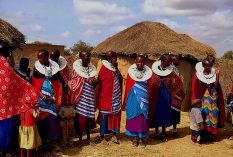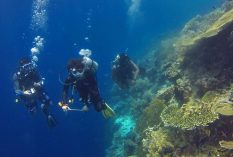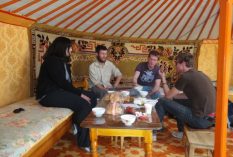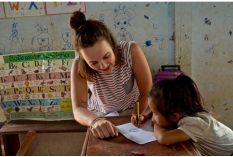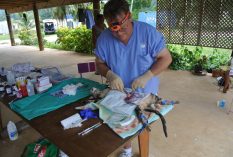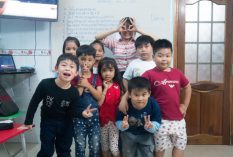My Internship with RUNA
Faith Jordan – March 2018 – Ecuador
How I discovered the opportunity:
 I first discovered an internship in Environmental Development and Agroforestry in Ecuador when I was coming to the end of the third year of my Environmental Science degree at university and looking for travel opportunities that would boost my career prospects. However, it wasn’t until over a year later, that I finally decided to look into this opportunity further and eventually make the decision to apply. I found the internship through the Global Nomadic website, so it wasn’t until I had a skype interview with a partner organisation – Amazon Learning – that I heard the name ‘Runa’. Amazon Learning is the project that supports interns at Runa, and other companies in the Amazon through their projects, so I have been lucky to have a strong support network from the beginning of my application, right through to the end. It is important to add, that my internship is with Fundación Runa – the non-profit organisation, not Runa LLC. – the business.
I first discovered an internship in Environmental Development and Agroforestry in Ecuador when I was coming to the end of the third year of my Environmental Science degree at university and looking for travel opportunities that would boost my career prospects. However, it wasn’t until over a year later, that I finally decided to look into this opportunity further and eventually make the decision to apply. I found the internship through the Global Nomadic website, so it wasn’t until I had a skype interview with a partner organisation – Amazon Learning – that I heard the name ‘Runa’. Amazon Learning is the project that supports interns at Runa, and other companies in the Amazon through their projects, so I have been lucky to have a strong support network from the beginning of my application, right through to the end. It is important to add, that my internship is with Fundación Runa – the non-profit organisation, not Runa LLC. – the business.
I decided to spend a total of 8 weeks working for Fundación Runa. During this time, I lived in the city of Tena, in ‘Casa Runa’, a place where all Runa interns can live if they choose not to do a homestay with a local family. During the early months however, there are a lot less interns, so I was the only one living at the house. Luckily, I was joined by Vanessa, Runa’s newly-appointed Communications Officer, who became my best-friend and partner in crime. I also had the company of 2 other Amazon Learning-supported interns, Maci and Renee, who were doing internships with different organisations in the region. Though they did not live in the Runa house, they were invaluable company.
My initial goals, for what I wanted to get out of my internship, were as follows:
- See for myself how the rain forest in Ecuador is being exploited for human use and to what extent this is causing deforestation
- Learn how NGOs can communicate and cooperate with local communities to protect forest areas
- Learn how agroforestry systems and sustainable management can help communities thrive
- Learn how scientific knowledge can be passed on to these communities in order for them to support the systems themselves
- Evaluate what else needs to be done in order to protect the forests and their connectivity and diversity
Runa Foundation
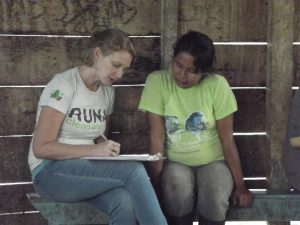 Initially, Runa was a business venture, started by American entrepreneurs who visited Ecuador and saw the potential for Guayusa (Ilex guayusa) to be marketed as a clean energy drink. Guayusa has been used to make tea by the Kichwa people of Ecuador for thousands of years and the cultivation and consumption of it is an important tradition. Runa has increased the publicity of guayusa and it is now gaining appreciation in other countries, for its high caffeine content and the demand for a natural energy drink. With this came a successful industry opportunity for a large number of Kichwa families, who up until this point, had only grown guayusa for their own consumption.
Initially, Runa was a business venture, started by American entrepreneurs who visited Ecuador and saw the potential for Guayusa (Ilex guayusa) to be marketed as a clean energy drink. Guayusa has been used to make tea by the Kichwa people of Ecuador for thousands of years and the cultivation and consumption of it is an important tradition. Runa has increased the publicity of guayusa and it is now gaining appreciation in other countries, for its high caffeine content and the demand for a natural energy drink. With this came a successful industry opportunity for a large number of Kichwa families, who up until this point, had only grown guayusa for their own consumption.
Off of this business came the idea to form a non-profit organisation, independent of the for-profit business, that would support these guayusa producers, and Fundación Runa (Runa Foundation) was created. Fundación Runa is a non-profit NGO whose mission is to ‘create new value for tropical forests that benefit local people and the forest ecosystem’.
To date, Runa has ensured:
- Over 141,000 native trees (including guayusa) have been supplied to farmers for reforestation and improved agroforestry systems
- This also influenced Ecuadorians elsewhere to plant guayusa, resulting in a total of 1.2 million guayusa trees being planted due to this multiplier effect
- 50,573 hectares of land has been placed under agroforestry and sustainable management systems
- $1,134,906 revenue has been generated for indigenous families through direct sales of Amazonian NTFPs (non-timber forest products)
- Women in leadership positions have gone from 11% to 50%
 Traditionally, the Kichwa people of this region manage their land in small agroforestry plots called ‘chakras’. Unlike traditional monoculture cropping systems, chakras are gardens full of a variety of native Amazonian plant species. The plants and trees are generally interspersed with each other, as the farmers know that this is how they grow naturally, so it is also how they will grow best. These chakras form a barrier between the rainforest boundary and the cleared land that people have created for their community houses. They prevent the over-exploitation of Amazonian produce and make it easier for the people to harvest their crops. Runa is helping farmers to go back to these traditional farming methods by creating new market value for tropical forests and chakra crops, so that communities are less likely to exploit the forests for short-term gain.
Traditionally, the Kichwa people of this region manage their land in small agroforestry plots called ‘chakras’. Unlike traditional monoculture cropping systems, chakras are gardens full of a variety of native Amazonian plant species. The plants and trees are generally interspersed with each other, as the farmers know that this is how they grow naturally, so it is also how they will grow best. These chakras form a barrier between the rainforest boundary and the cleared land that people have created for their community houses. They prevent the over-exploitation of Amazonian produce and make it easier for the people to harvest their crops. Runa is helping farmers to go back to these traditional farming methods by creating new market value for tropical forests and chakra crops, so that communities are less likely to exploit the forests for short-term gain.
One tree species that Runa is particularly interested in is chuncho (Cedrelingo canteniformis). This is a native tree that the community can harvest after 20 years of cultivation. The wood is used for timber to sell, as chuncho are particularly fast-growing and valuable within the timber market. During the 20 years of their growth they provide a host of benefits to the environment, including; mitigating climate change through carbon sequestration, increased canopy cover, soil nutrient enrichment and increasing biodiversity. After harvesting, new trees should be planted, to repeat the process and continue the cycle of creating both environmental and economic benefits.
What I did and what I learnt:
During the 7 weeks of my internship, after the initial orientation, I spent around 50% of my time in the Runa office and the remaining time participating in field trips into the communities. I visited 7 communities in total; learning about the projects that Runa is running and the impact of agroforestry systems on both the people and the landscape. What I learnt on each field trip is detailed below.
- Campana cocha, Ajauno (03/02/18)
– my first field visit – a plant nursery
I visited a secluded, 100-hectare plot of land, that the owner has decided to partially use for agroforestry. He hopes to maintain the area of primary forest as a wildlife reserve and then manage the remaining secondary forest for timber production. The small community that lives next to his land were very welcoming and one family has been brought in specifically, to oversee the creation of a tree nursery; to cultivate chuncho (Cedrelingo canteniformis); a species that holds high economic value. I was interested to learn more about this system and its pros and cons for both the local ecosystem, and the people who live nearby.
- Mushullakta (06/02/18)
– Exploring a chakra for the first time and documenting the corn harvest
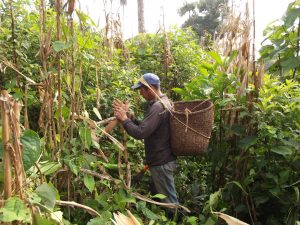 Me and Vanessa (Runa’s Communications Officer) visited Mushullakta; one of the rural communities that Runa is working with to re-forest previously cleared land, over a 2-day period. We stayed with the Narvaez family, who showed us around their chakra and told us how farming this way is benefiting them. We visited 3 chakras in total and it was clear to see how productive they were at providing the families with a diverse range of both food and commercial crops. Like the land I visited previously, they too have a tree nursery, and are growing chuncho seedlings to plant in amongst their chakras as part of the reforestation plan, and to eventually provide timber they can sell. These chakras create a riparian buffer zone between the communities and the neighbouring, UNESCO-designated Sumaco Biosphere rainforest reserve, mitigating some of the effects of human settlement. The next day, the community members came together in the morning to clear a space in which to construct a shelter for their harvested crops. They then used their machetes to move their way through the undergrowth and make a path towards their maíz crops. They cut the corn ears from the stalks, then threw them into the baskets on their backs. Once they had filled a basket, they took it back to the sheltered spot and emptied it out, before returning to the field to repeat the process. My job was to take photos and ask questions about the harvest in order to create a blog post for the Runa website; inspiring me to think about creating my own blog to share my experiences.
Me and Vanessa (Runa’s Communications Officer) visited Mushullakta; one of the rural communities that Runa is working with to re-forest previously cleared land, over a 2-day period. We stayed with the Narvaez family, who showed us around their chakra and told us how farming this way is benefiting them. We visited 3 chakras in total and it was clear to see how productive they were at providing the families with a diverse range of both food and commercial crops. Like the land I visited previously, they too have a tree nursery, and are growing chuncho seedlings to plant in amongst their chakras as part of the reforestation plan, and to eventually provide timber they can sell. These chakras create a riparian buffer zone between the communities and the neighbouring, UNESCO-designated Sumaco Biosphere rainforest reserve, mitigating some of the effects of human settlement. The next day, the community members came together in the morning to clear a space in which to construct a shelter for their harvested crops. They then used their machetes to move their way through the undergrowth and make a path towards their maíz crops. They cut the corn ears from the stalks, then threw them into the baskets on their backs. Once they had filled a basket, they took it back to the sheltered spot and emptied it out, before returning to the field to repeat the process. My job was to take photos and ask questions about the harvest in order to create a blog post for the Runa website; inspiring me to think about creating my own blog to share my experiences.
- Puni Kotona (15/02/18)
– Meeting about peanut production successes and failures
I went to a community meeting in Puni Kotona, that the Runa staff had organised to gather feedback from the farmers, on how well their peanut production and sales were going. We also donated a truck load of chuncho seedlings to them. This trip made me realise how much work goes into forming a good relationship with the farmers, in order for them to share their stories and opinions with you.
- Flor de Bosque (16/02/18)
– GPS mapping for biodiversity survey sites
I visited a chakra in Flor del Bosque, along with Vanessa, and my Runa supervisor, to take GPS coordinates of the different crop boundaries. These will then be used to create a map of the chakra and biodiversity surveys will be carried out in each section, to analyse the impact of different farming techniques and different crop plantations on the species that can remain in that habitat.
- Lupino (21/02/18)
– Checking on project progress
I accompanied Leonidas (Runa staff member) on a mission to Lupino. We spent almost 6 hours travelling to a house in the remote Amazon, all to spend 20 minutes there to check up on their chuncho nursery, then make the journey home. It was a long day, but an awesome adventure. It is important for Runa to check up on the families and communities they work with, to ensure the projects are going to plan, even if that means a lot of physical labour.
- La Libertad, Archidona (22/02/18)
– Experiencing a traditional Guayusa ceremony
Me and my Sinchi Warmis (‘strong women’ in Kichwa) got up at 3.30am to spend the morning experiencing a Guayusa Ceremony. We learnt about the traditions of how the women in a community brew the guayusa in the early hours so that the men can have a high-energy drink before going out into the forest to hunt food for the family. It is this ceremony that first attracted Runa LLC.’s founder to the potentials of guayusa, and a tradition that the community members of La Libertad still practice to this day. Also, during the ceremony, Vanessa and Renee got their faces spat on by a shaman, all in the name of being ‘cleansed’.
- Liquino (07/03/18)
– Chuncho seedling collection
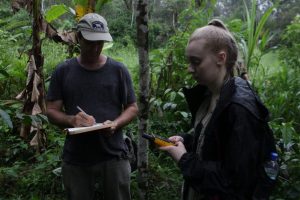 For one week in March, each year, the chuncho trees release tens of thousands of seeds to the forest floor. This dispersal technique evolved to ensure that there were so many of the seeds, they simply could not all be eaten by ground-dwelling seed eaters, ensuring that a large number would still germinate. Our mission was to find a chuncho tree that had recently released its seeds, so that we could collect ones that had recently germinated into small seedlings. Last year, a group from Runa went to the same area of forest and collected the seeds, but these proved to have a high mortality rate once they had been planted in nurseries back in the city. This year, I was the only intern to go on the 3-day adventure, joined by Vanessa and my Runa supervisor, Ian. We also had the help of Ian’s business partner, his son, and a group of men from the community once we arrived.
For one week in March, each year, the chuncho trees release tens of thousands of seeds to the forest floor. This dispersal technique evolved to ensure that there were so many of the seeds, they simply could not all be eaten by ground-dwelling seed eaters, ensuring that a large number would still germinate. Our mission was to find a chuncho tree that had recently released its seeds, so that we could collect ones that had recently germinated into small seedlings. Last year, a group from Runa went to the same area of forest and collected the seeds, but these proved to have a high mortality rate once they had been planted in nurseries back in the city. This year, I was the only intern to go on the 3-day adventure, joined by Vanessa and my Runa supervisor, Ian. We also had the help of Ian’s business partner, his son, and a group of men from the community once we arrived.
The first day of our trip was taken up purely by travelling to the community of Liquino where we would base ourselves for the trip, as it is many miles away from Tena, and situated in remote Amazon rainforest, so took a long time to get there. We had to cross multiple rivers by canoe and by foot, carrying all our equipment and food with us. We were advised by the community members to wait until the morning of the day we would be leaving to collect the seedlings, so that they would be exposed for as little time as possible.
On our free day, we went on an exploratory hike through the forest. We were greeted by another community and found an abandoned cabana in the middle of nowhere. This used to be a luxury getaway for tourists but has since been abandoned and is now being taken over by nature. In the afternoon, we moved the other seedlings (that Runa is buying from one of the community members), to a better location ready for pick-up the next day. This was also international women’s day, so me and Vanessa had our faces painted with orange paint from the Achiote fruit and were crowned as ‘las reinas de la selva’.
On the third day we hiked into the forest and eventually found 2 mature chuncho trees surrounded by small seedlings they had recently released. Everyone got to work collecting as many seedlings as possible until it was clear that we had exhausted the supply. Bunches of chuncho were held together, wrapped in a parcel of soil and held together with a leaf. This process keeps the roots of the seedlings damp and protected. We transported all of the seedlings back to Tena that afternoon.
My Main Project
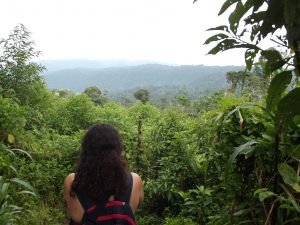 The seeds that were collected on this last trip to Liquino, were key to my main project with Runa Foundation; the creation of a ‘vivero’, or plant nursery. I played a key role in organising the set-up of this project, and with the help from my Runa colleagues, succeeded within 4 weeks. The vivero will be used to continuously cultivate economically valuable native plants that the foundation can donate back to local farmers to enhance the biodiversity of their agroforestry systems. The first step in achieving this was to meet with the Municipality of Tena to negotiate a suitable location where the nursery could be constructed. We explained the motivation behind the project and secured a plot of land that they agreed could be used. I coordinated with other Runa staff and contractors to organise the clearing of the plot in preparation for its development and we all helped fill the planting bags ready for the seedlings. Once all the desired plant seedlings had been collected from Liquino and transported back to the nursery site, we spent 3 days planting them into the bags. The vivero will be looked after by Runa staff and future interns and continuously topped up with new seedlings of a variety of species, once the original collection is used for subsequent reforestation efforts.
The seeds that were collected on this last trip to Liquino, were key to my main project with Runa Foundation; the creation of a ‘vivero’, or plant nursery. I played a key role in organising the set-up of this project, and with the help from my Runa colleagues, succeeded within 4 weeks. The vivero will be used to continuously cultivate economically valuable native plants that the foundation can donate back to local farmers to enhance the biodiversity of their agroforestry systems. The first step in achieving this was to meet with the Municipality of Tena to negotiate a suitable location where the nursery could be constructed. We explained the motivation behind the project and secured a plot of land that they agreed could be used. I coordinated with other Runa staff and contractors to organise the clearing of the plot in preparation for its development and we all helped fill the planting bags ready for the seedlings. Once all the desired plant seedlings had been collected from Liquino and transported back to the nursery site, we spent 3 days planting them into the bags. The vivero will be looked after by Runa staff and future interns and continuously topped up with new seedlings of a variety of species, once the original collection is used for subsequent reforestation efforts.
I have written a report on the vivero, detailing all stages of its creation, the species we have planted so far and instructions for the next steps that need to be taken for its maintenance and improvement. This will be used to educate and inform new Runa interns.
Other projects that I completed, within the Runa office, included; data entries from questionnaires about peanut production, proof reading Runa publications and translating them into Spanish, editing farmer profiles for the foundation’s website, writing blog posts and posts for social media about my experiences, and writing a proposal and budget for an urban garden on the Casa Runa terrace.
Summary
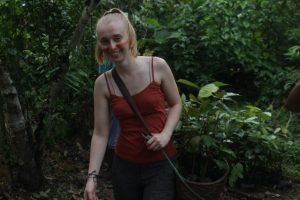
Overall, I had an amazing experience with Runa Foundation and loved my chance to work in the Amazon rainforest. I learnt so much about agroforestry and the
workings of NGOs, and this new skill-set is already helping me to enhance my CV and job applications. I feel that I achieved all of my initial learning goals through my research, field trips and conversations with the farmers and Runa staff.
I really appreciated all the help from my supervisors at Amazon Learning. They were a huge help in answering all my queries about living in Tena before I arrived, and so supportive during my stay.
Agroforestry & Environmental Development Internships in Ecuador

